A Comprehensive Guide To Explore Plaza Mayor In Madrid

At the heart of Madrid lies Plaza Mayor, a grand testament to Spain’s rich history. This iconic square has witnessed everything from royal celebrations to public executions. Today, it stands as a bustling hub of activity, drawing locals and tourists alike with its stunning architecture, lively cafes, and street performers. As you step into this expansive rectangular space, surrounded by three-story residential buildings with 237 balconies facing the plaza, you’re instantly transported to a world where past and present seamlessly blend. This explores the captivating allure of Madrid’s crown jewel.
About Plaza Mayor
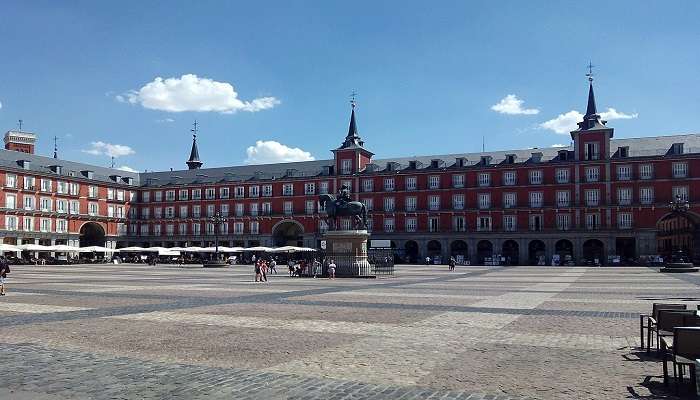
The Plaza Mayor is a historic and iconic public square. Constructed between 1580 and 1619 during the reign of Philip III, it has been a central gathering place for centuries. The rectangular square, measuring 129 meters by 94 meters, is surrounded by three-story residential buildings with 237 balconies overlooking the plaza.
Over the years, it has hosted numerous significant events, including markets, bullfights, public executions, and celebrations. Today, it remains a popular spot for both tourists and locals, featuring outdoor cafes, restaurants, and annual events such as the Christmas market.
Also Read: El Retiro Park
History Of Plaza Mayor
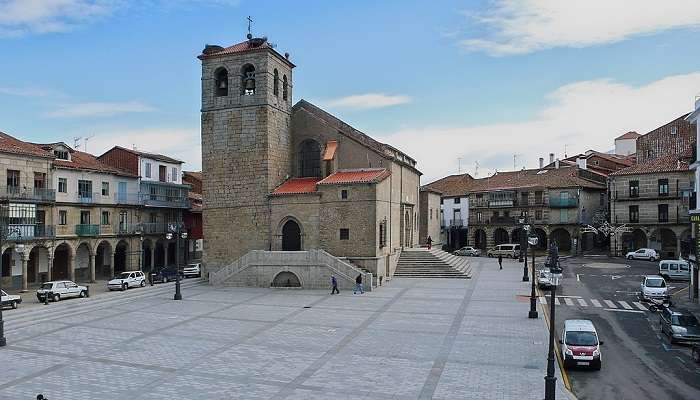
The Plaza Mayor in Madrid has a long history, which can be traced back to the 15th century when it was called the “Plaza del Arrabal” and was the central marketplace of the town. In 1561, the plaza was given to the city of Madrid, and King Philip II ordered the plaza to be redesigned by architect Juan de Herrera. The construction of the church started in 1617 during the reign of Philip III and was completed in 1619.
The plaza has had three major fire incidences. The first fire occurred in 1631, and Juan Gómez de Mora rebuilt the plaza. The second fire was in 1670, and Tomás Román rebuilt it. The last fire was in 1790, and it destroyed one-third of the square. The reconstruction after this fire was done by Juan de Villanueva, who reduced the height of the buildings around it from five to three stories, closed the corners and made large arches leading to the square.
Construction, however, continued after the death of Villanueva and was completed in 1854 by Villanueva’s students, namely Antonio López Aguado and Custodio Moreno. Over the years, the it has been employed for different purposes, such as bullfighting, executions, trials during the Spanish Inquisition, and even the crowning of Kings. Currently, it is a tourist attraction where tourists come to practice yoga and attend concerts, festivals, and other events, including the Christmas market that has been conducted since 1860.
Architecture Of Plaza Mayor
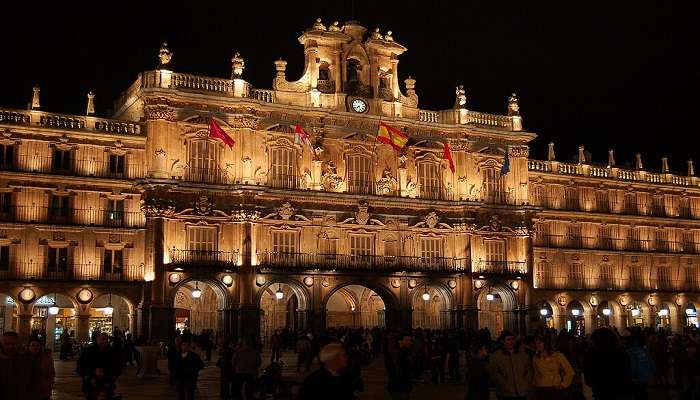
The Plaza Mayor is a rectangular-shaped square that is 129 meters in length and 94 meters in width. The building is surrounded by similar three-storeyed residential houses with 237 balconies overlooking the square. The building design is Spanish Baroque with red brick exterior, and there is not much variation in the design of the buildings. The square has ten gates, and in the centre of the square, there is a bronze sculpture of King Philip III on a horse, which was installed in 1848.
The frontages of the structures have paintings and elaborate designs on their exteriors: the nine gateways and the towering clock tower in the central part of the square. The most important building is the Casa de la Panadería, situated in the northern part of the square. Juan Gómez de Mora was the first one to design it, and this has been used as a model for future reforms in the square.
The architectural style can be described as a reflection of the Spanish Habsburg architecture with a focus on the power and prosperity of the Spanish empire at the time. The square occupies a vast area of 12000 sq.m and is surrounded by three-storied residential houses of identical architecture. These structures together with 237 balconies give an excellent view of the active square.
Related Post: Seville In Winter
Statues At Plaza Mayor
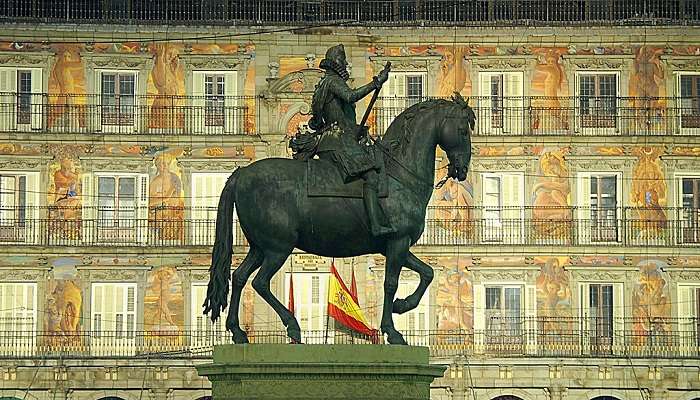
The Plaza Mayor in Madrid is home to several notable statues, each with its historical significance. At the centre of the square stands the bronze statue of King Philip III, created in 1616 by Jean Boulogne and Pietro Tacca. This equestrian statue was a gift from the Duke of Florence and was not placed in the centre of the square until 1848, following an order by Queen Isabel II to move it from Casa de Campo.
Another important statue is that of Don Blas de Lezo y Olavarrieta, a Spanish admiral who served in the defence of Cartagena de Indias during the War of Jenkins’ Ear. These statues not only enhance the aesthetic value but also act as a historical and cultural reference to Spain.
Entrance Fees And Timings
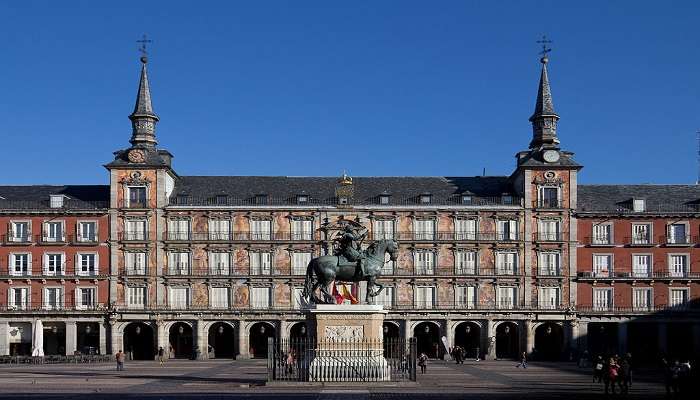
The Plaza Mayor is one of the most famous places in Madrid, and every tourist should visit it while in the city. The square is not closed at night, and this gives visitors the best chance to see the place during the day and night.
Interestingly, there is no charge applied when one wants to access the Plaza Mayor; therefore, it is open to tourists and residents. If you want to learn more about history, enjoy the architectural design, or have a cup of coffee at one of the numerous cafes nearby, the Plaza Mayor is open to you without any charge, which makes it even more attractive as a central square in Madrid.
Related Post: Churches In Seville
Best Time To Visit
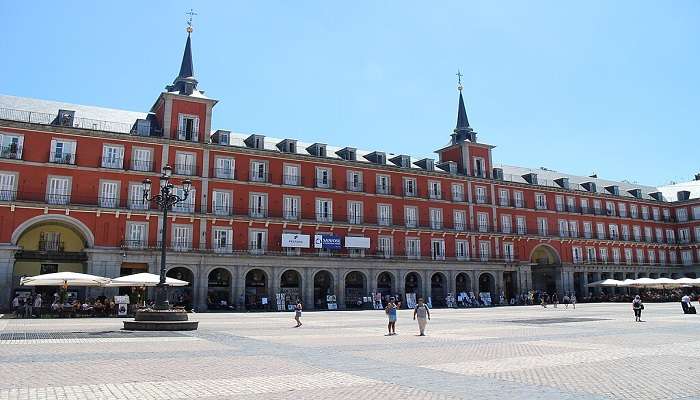
The best time to visit Plaza Mayor in Madrid is during the spring (April to June) and autumn (September to November) when the weather is pleasant and ideal for exploring the square and its surroundings on foot. These seasons offer mild temperatures and fewer crowds compared to the summer months, which can be quite hot and busy with tourists. To avoid larger crowds and fully appreciate the historical landmarks and vibrant atmosphere of Plaza Mayor, it’s also recommended to visit early in the morning or later in the afternoon.
How To Reach?

Reaching Plaza Mayor in Madrid is convenient, with several transportation options available. Below is a detailed guide on how to reach Plaza Mayor using these various modes of transport:
By Air
Madrid-Barajas Adolfo Suárez Airport (MAD) is the main airport serving Madrid. You can take a taxi from the airport to Plaza Mayor, which takes around 20-30 minutes but is the most expensive option. Alternatively, you can take the metro: Line 8 (pink) from the airport to Nuevos Ministerios, then transfer to Line 10 (dark blue) to Tribunal and finally switch to Line 1 (light blue) to Sol. Plaza Mayor is a short walk from Sol station. Another affordable option is the airport shuttle bus, which will take you to the city centre, from where you can take a short walk or a metro ride to Plaza Mayor.
By Rail
If you prefer to come by train, then Atocha is one of the largest stations in the city. From Atocha, you can take Line 1 (light blue) straight to Sol station, and Plaza Mayor is just a few steps away from it. If you are at Chamartín Station, take light blue line 10 to Tribunal and then change to light blue line 1 to Sol. The closest metro station is Sol, which connects to Line 1 (light blue), Line 2 (red), and Line 3 (yellow).
By Bus
City bus lines that are close to Plaza Mayor include 002, 17, 3, 60, and C1. The bus schedule and routes can be obtained from the local transportation website or by using the Moovit application for real-time information. If you are coming from other cities, intercity buses will drop you at the central bus stations in Madrid. From there, one can take a metro or city bus to Plaza Mayor.
You May Also Like To Read: Summer In Spain
Starting from the architectural design of the building to the bustle of the people within the premises, Plaza Mayor gives the true feel of Spain. Whether you are enjoying a glass of sangria in a café, watching a street show, or just feeling the atmosphere of the place, you will not remain indifferent in Plaza Mayor. Having read about its history and the current attraction, why not visit the place yourself? Do not just imagine yourself standing in the heart of Madrid and making it a reality. Don’t wait any longer and book your trip to Spain now to discover the charm of Plaza Mayor and many other places you will find in this country. Welcome to your Spanish journey, which is starting right now!
For our editorial codes of conduct and copyright disclaimer, please click here.
Cover Image Credit : Anual for Wikimedia Commons
Frequently Asked Questions About Plaza Mayor
What is special about Plaza Mayor?
Plaza Mayor is a historic square in Madrid renowned for its magnificent architecture, lively atmosphere, and deep historical significance. It has served as a central gathering place for centuries.
What is the statue in Plaza Mayor?
The statue in Plaza Mayor is of King Philip III on horseback, designed by Giambologna and completed by Pietro Tacca in 1616.
What events have taken place in Plaza Mayor?
Plaza Mayor has hosted various events, including bullfights, executions, markets, and cultural festivals. Today, it's famous for its Christmas market and public gatherings.
Is Plaza Mayor free?
Yes, visiting Plaza Mayor is free. You can explore the square and enjoy its historic surroundings without any entrance fee.
Do people live on Plaza Mayor?
Yes, residents live in the buildings surrounding Plaza Mayor, with many apartments featuring balconies that offer views overlooking the bustling square.
People Also Read:
Madrid In June Museums In Madrid Castles In Madrid

With a passion for exploring and travelling to the roads long forgotten, experience the world through enthralling stories and adventures. Join me as I share my experiences at some of the world’s most popular tourist destinations and quench that pestering curiosity with something exciting!











